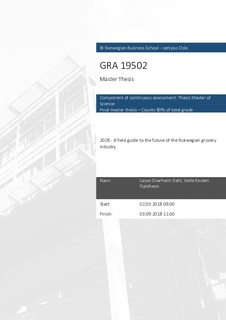2028 - A field guide to the future of the Norwegian grocery industry
Abstract
In this paper we have sought to identify key drivers that will shape the Norwegian
grocery industry the next ten years, with the final result being four scenarios revealing ranges
of plausible development in the future. We utilized a well-established framework for
performing a scenario analysis, following the work of two prominent scholars within the
field, Paul J. H. Schoemaker and Kees van der Heijden.
We performed 7 in-depth interviews with industry experts and executives from the
industry. Secondary data from academic articles, industry specific reports and news articles,
supplemented insights from the interviewees. After a thorough process of analysis, we
identified 18 drivers, that was later clustered and cut down to four key drivers. These key
drivers are what we consider to be the most prominent driving forces in shaping the future of
the industry. For each key driver we did a literature review of the topic, while also discussing
the empirical findings collected through the in-depth interviews. To create the scenarios, we
employed a 2x2 scenario matrix with two axes: liberalization of trade policies, and
innovativeness and adoption of new technology. The four scenarios that emerged were
presented as logically constructed narratives that describe the future situation.
Finally, we draw some managerial conclusions. In short, there are areas in which
grocery chains have full autonomy, and there are areas that they don’t. Changes in political
climate is something that for the most part, is out of their control. However, innovativeness
and the willingness to adopt new technology is naturally an area in which the industry
representatives have full autonomy. The narratives present the different players in the
industry as acting uniformly to all the scenarios in this paper, and so, every scenario
represents a threat or opportunity for the industry as a whole.
Description
Masteroppgave(MSc) in Master of Science in Strategic Marketing Management - Handelshøyskolen BI, 2018
